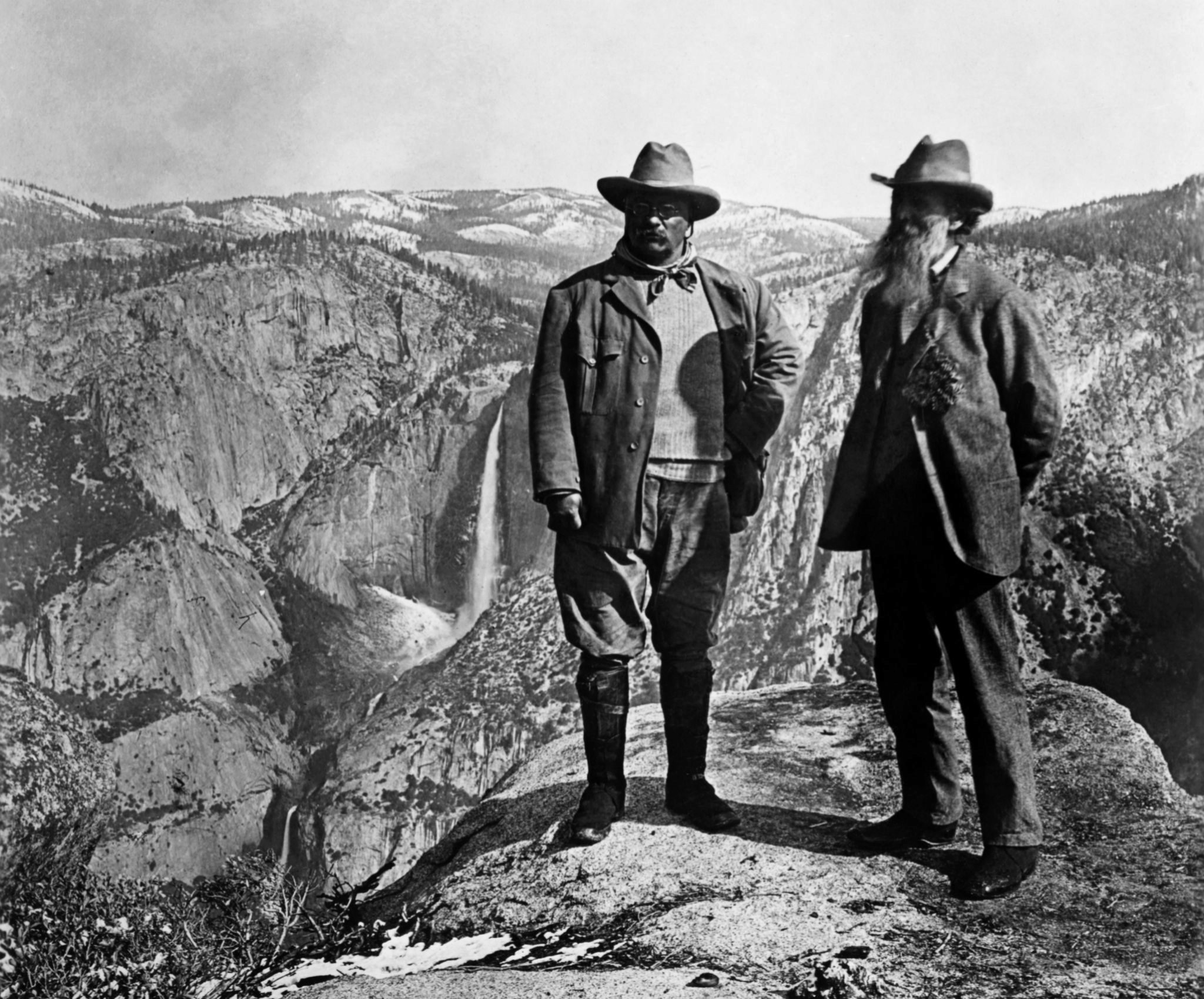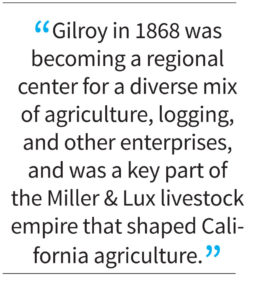Guest column by George Fohner – Celebrating John Muir’s trip through South Valley 150 years ago
Published in the May 2 – 15, 2018 Issue of Gilroy Life

George Fohner

Teddy Roosevelt visited John Muir at Yosemite.
One hundred and fifty years ago last month, John Muir arrived in California for the first time and began his storied walk from Oakland to Gilroy, over Pacheco Pass, and on to Yosemite. Already well traveled in the wilds of North American by the time of his arrival in California at age 30, Muir would go on to become the patron saint of the conservation movement, forever associated with the Sierra Nevada and the conservation of wild places. As Muir moved south of San Jose into the southern Santa Clara Valley on that walk to Yosemite, he was completely enthralled with his surroundings. He likened the fresh, springtime air spiced with fragrance of wildflowers to the “breath of angels,” calling it the most invigorating that he had ever experienced.
He describes the area as being an “Eden from end to end: Air pure and bright, tempered with sunshine, alive with song of meadowlark and streams tumbling in sparkling rills down from hill to valley floor.”
 Muir marveled at the forests of redwoods that cloaked the mountains to the west and mix of oaks and grasses to the east while he wandered through rich bottom-lands that glowed with vast expanses of wildflowers of white, yellow, and purple, sparkling with highlights of red and blue in a tapestry with vivid green grasses. Muir equated his experience traveling through southern Santa Clara Valley to a baptism that awakened in him a new capacity for happiness. His euphoric descriptions rival the glorious descriptions of the Sierra Nevada that brought him international acclaim.
Muir marveled at the forests of redwoods that cloaked the mountains to the west and mix of oaks and grasses to the east while he wandered through rich bottom-lands that glowed with vast expanses of wildflowers of white, yellow, and purple, sparkling with highlights of red and blue in a tapestry with vivid green grasses. Muir equated his experience traveling through southern Santa Clara Valley to a baptism that awakened in him a new capacity for happiness. His euphoric descriptions rival the glorious descriptions of the Sierra Nevada that brought him international acclaim.
Exhilarated as he was about the natural wonders around him and captivated by the novelty and beauty of the California landscape that he was seeing for the first time, Muir in his writings about the trip barely mentions the names of the communities that he passed through on his way from Oakland to Pacheco Pass. He does mention Gilroy, however, because it was here that he turned east to leave the Santa Clara Valley on his way to the pass. Gilroy in 1868 was becoming a regional center for a diverse mix of agriculture, logging, and other enterprises, and was a key part of the Miller & Lux livestock empire that shaped California agriculture. If Muir spent time in Gilroy, he might well have encountered William Hanna, a leading citizen of Gilroy at the time and for many years thereafter. Hanna was one of the trustees when Gilroy incorporated as a town in 1868 just weeks before Muir passed through and was a councilman when Gilroy incorporated as a city in 1870, later becoming mayor. Almost 40 years after Muir’s 1868 journey, William Hanna’s grandson, Tom Hanna, married Muir’s daughter Wanda. Tom went on to manage Muir’s farming business near Martinez during Muir’s later years when Muir devoted his time and energies to advocating for the protection of Yosemite and other wild-lands.
Muir’s enthusiasm for his surroundings did not diminish as he headed east from Gilroy toward Pacheco Pass. Regaled with “shouts” of quail and the song of streams cascading into valley, Muir frequently departed the road to explore the “rich garden” on sunlit hillsides, in shady, fern-filled grottoes, and in the cobble stream-bed where Pacheco Creek meandered back and forth in the midst of sycamore, alder, and dogwood. Here Muir also likely saw cattle owned by Miller & Lux grazing on valley pastures and adjacent hillsides of grass, oak, and chaparral. Along the way Muir almost certainly crossed paths with freight and livestock that the company was constantly moving over the pass between Gilroy and its ranches in the San Joaquin Valley. Muir even may have seen Henry Miller on horseback on one of his regular treks between his Gilroy home ranch and those San Joaquin ranches.
Like Muir, Henry Miller recognized the rare value of the southern Santa Clara Valley. Of the million and a half acres Miller owned, and the vastly larger area he controlled by lease or other means in valleys and mountains throughout the west, he favored the Gilroy area as his business headquarters, home, and vacation retreat. He referred to his Bloomfield Ranch just south of Gilroy as the “center place,” reflecting both its importance to his business as well as its geographic location. Miller’s life revolved around work, but he treasured spending Sundays and his brief vacations with family on his land at Mount Madonna and took great pleasure in hosting employees and business associates there.
John Muir and Henry Miller are not generally thought of as having similar perspectives on the environment or its use, but they clearly considered the southern Santa Clara valley to be a special place. Both also were in fact similarly frugal and conscious about using natural resources wisely and not squandering them.
The 150th anniversary of Muir’s arrival in California and walk through Gilroy comes at a time when land use decisions affecting Gilroy and its surroundings are being made under intense budgetary and development pressure. Blessed with a sense of community, fertile farmland, scenic productive rangeland, splendid parks and wild-lands, and a strategic location among natural and man-made wonders known worldwide, few places can match what this area still has to offer. Both Muir and Miller undoubtedly would agree that current residents of the area and their elected officials should not undervalue this extraordinary area as they make decisions that will affect the quality of life here far into the future.
George Fohner has lived and worked in Gilroy for 34 years.
- Guest column by Jaci Muro: Gilroy Foundation supports young people with college scholarships - March 30, 2024
- Your Retirement … with Marisa Otto: Financial freedom can be a great gift for you and your family - March 30, 2024
- Your Garden … with Sharon McCray: Oxalis Californica can be an amazing addition to your garden, or a nuisance - March 30, 2024
